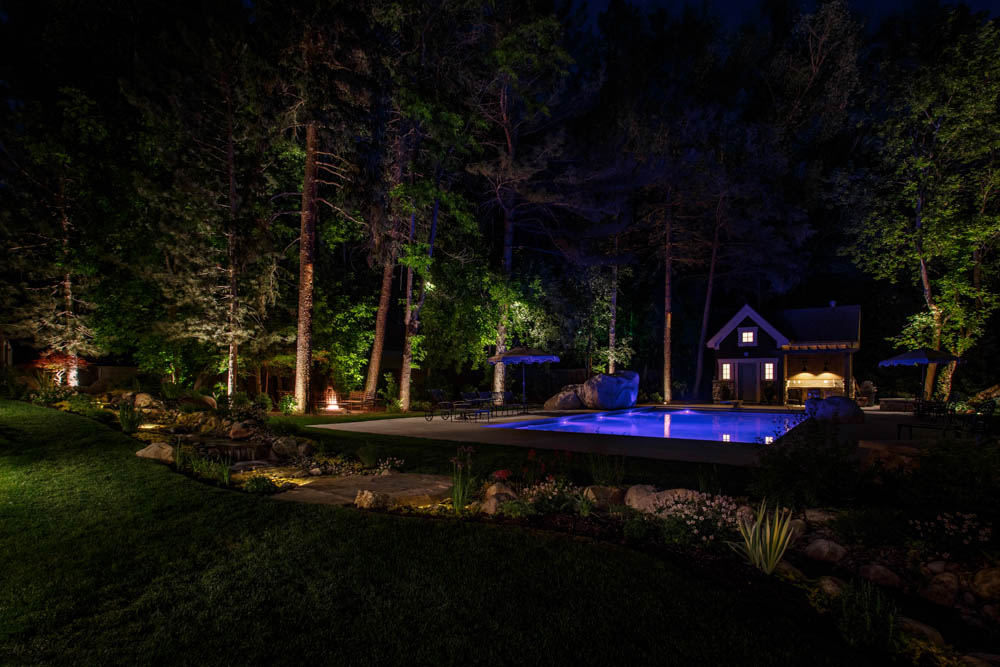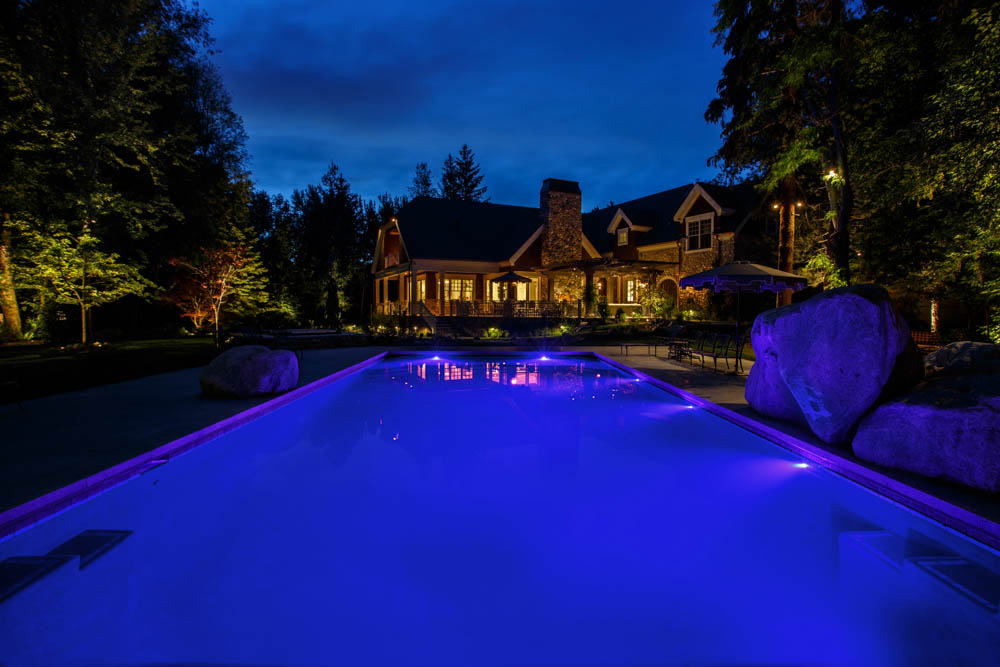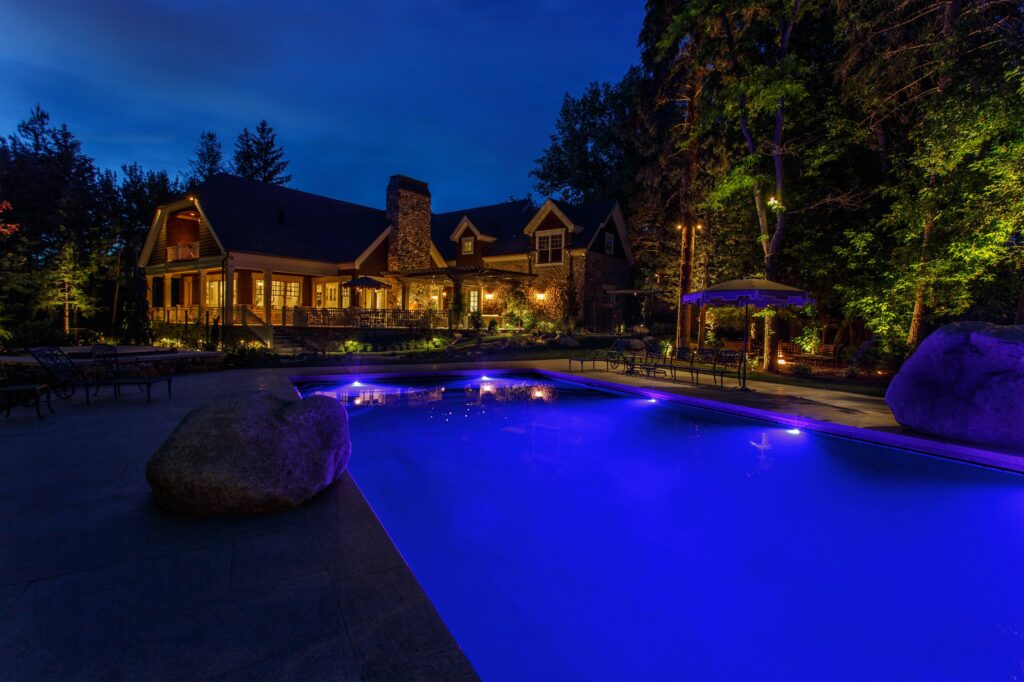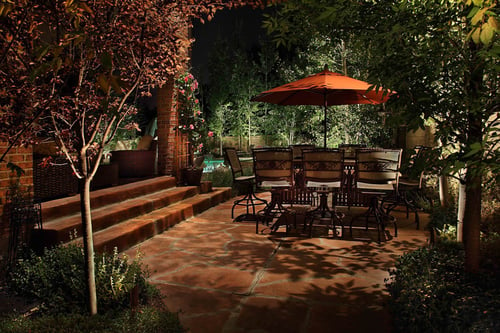Swimming pool lighting techniques to add beauty & function to your summer nights
Let’s discuss some of the things professional lighting designers think about when implementing swimming pool lighting techniques to add beauty and function to your summer nights.
Why do I need landscape lights when my pool already has lighting?
- The light from the pool is not enough for outdoor entertaining.
- Landscape lights can provide task light for entertaining and create a cohesive lighting design.
- The pool’s light is ideal for creating a beautiful and balanced design.
Pool lighting
Let’s take a look at a swimming pool, and explore how its different facets help to create an ideal nightscape.

The lighting design around a pool requires special attention.
There is the light coming from the pool itself to consider, but many outdoor lighting techniques also need to be carefully calculated.
Downlighting, for example, needs to be approached with a skilled eye.
If done incorrectly, down lighting can become a reflected up light on the water’s surface and potentially cause glare.
At night, no one wants a bright light shining up into their eyes from the water’s surface.
Swimming pool lighting techniques
This brings us to the topic of the three main lighting techniques employed in any well-thought-out lighting design: ambient, task, and accent lighting.
Layering these three approaches in the above lighting design requires an artistic eye, a strong understanding of outdoor lighting, and the ability to leverage a well-rounded lighting design.
1. Ambient light
For ambient light, the entire space is lit well, acts as a point of gathering for guests, and provides the overall outdoor living space with spacious illumination.
The pool itself is the focal point and renders the whole space in a soft blue glow.
The downlighting from the trees to the left and right creates a circular path that softly captures the pool deck to lead people around the entire pool.
2. Task light
The hidden light beneath the bridge over the stream is a form of path lighting used to accentuate and suggest movement.
Rather than have a path light placed over the stone bridge, the light is placed below in the stream to define the bridge’s edge and help people navigate back and forth from the pool to the house.
The most effective lighting is found when it’s used to enhance design elements, rather than try to work against them.
3. Accent light
Capturing the landscape with well-positioned lights helps the viewer’s eye move from point to point and take in the different landscape elements.
Accent lights on the trees are essential to layering the landscape lighting to enlarge and expand our perception of the outdoor living space.
If we look closely at the pool depicted above, the illuminated pool house in the background and the soft-up lighting on the trees are all equally dynamic at balancing the pool lighting beautifully.

Layering
Layering different lighting techniques helps to create a lighting design that feels intimate.
Simply put, experiencing our surroundings in a way that mimics what we are used to seeing in the world around us is done by layering two elements: light and shadow.
Shadows actually help to connect the different objects in the landscape into a cohesive whole and add depth. Too much light makes everything appear flat and dimensionless, while not enough light leaves the viewer with an uncanny feeling.
Color
Contrast between the warmer colored lighting surrounding the pool’s exterior, and the blue hue of the underwater lights contained within the pool itself make the lighting design more visually appealing.
Lit from within, this pool is a strong visual focal point for the entire outdoor living space.
At night, color can provide eye-catching effects.
We sense blue, red, and green colors with the rods in our eyes.
Since blue is a color that our eyes sense using rods, which our eyes happen to have far more of than cones, lower amounts of blue light are all that’s required for us to identify and distinguish it from the rest of the landscape.
In other words, lower blue ambient light levels emitted from the pool are ideal. Bright blue lights are an eyesore for us to visually confront. This is especially true at night where a soft blue light is all that is needed.
Small doses of colored light are all that our visual needs require in outdoor situations.

Above, you can see how the pool is essentially one large ambient plane where the inner lights sharply define the pools edge while splashing a soft luminous glow onto the rocks, umbrellas, and upper canopies of the trees.
Even though the pool isn’t overly bright, it still maintains a firm visual weight. Using this blue hue alone wouldn’t be very effective, however, since it doesn’t add any depth to the lighting design.
Shadows are the key to discerning depth. Lower lighting levels are ideal for creating shadow and contrast.
Here, we’ve introduced accent lighting on trees and other landscape features to establish and define these shadows and provide people with enhanced depth perception. Looking at even just these pictures, you can tell how far away objects are from the viewer as a result of the contrast between shadows and light.
Adding beauty and enjoying your pool at night can be achieved by capturing the different elements throughout your landscape. The way to capture them is through low ambient light levels that draw the viewer in.
Quick Aside about Landscape Philosophy / Theory
(Why Seeing Your Landscape at Night Will Improve & Make Your Outdoor Living More Enjoyable)
In 1975, Jay Appleton published, The Experience of Landscape, in which he discusses his ideas about prospect-refuge theory. In a nutshell, Appleton’s theory discusses how we experience the aesthetics of landscape in the form of prospect and refuge.
In his book, Appleton explains why certain environments feel safe and secure, and thus meet our need for refuge.
From a place of refuge, comes prospect.
Prospect is the ability to look out from the place that provides us with a sense of refuge and observe the greater / larger space around us.
To simplify, Appleton argues that these two ingredients (prospect and refuge) are essential to psychologically experiencing the aesthetic joy a beautiful landscape can bring.

If we apply Appleton’s theory to our own landscapes, we can see what Appleton is describing.
When we are sitting on our patio, we are experiencing prospect refuge theory. The patio is the place we can go to retreat from the reset of the world, even for only a minute. The patio is our haven, our place of serenity.
From the patio, we can look out into our backyard and experience the pleasure of observing what’s around us from our place of refuge.
From a psychoanalytical perspective, this is why Appleton will argue sitting on the patio is such an enjoyable experience. From a place of safety, we can look out into what is happening around us.
Landscape lighting is important because it allows us to extend the enjoyment our landscape brings us into the night.
When it comes to finding joy in your pool area at night, landscape lighting couldn’t be more important. The landscape isn’t worth lighting just because it looks pretty.
When we light the perimeter of our landscape at night, it actually does something psychologically to enhance our sense of privacy and seclusion by providing us with more visual control over our surroundings.
Lighting the exterior of our pools isn’t about pretty lights, it’s about enjoying our outdoor living space, our place of refuge, to its fullest.
Landscape Lighting Makes All The Difference
At Landscape Lighting Pro of Utah, the art of outdoor illumination is a real passion we work to perfect. Designing elegantly bespoke landscape lighting systems is simply all we do. For over 15 years, our award winning team of designers and craftsmen have striven to bring the best outdoor lighting experience possible to people’s homes and businesses across the Wasatch Front & beyond.
Located in Midvale, Landscape Lighting Pro of Utah installs, maintains, and repairs lighting systems throughout Utah’s residential areas, including Salt Lake City, Park City, Draper, Davis, and Utah Counties.
If you have an upcoming project you’d like help with, call (801)440-7647 for more information, schedule a free consultation, or feel free to simply fill out a contact form.
Salt Lake City (Midvale)
801-440-7647
St. George
435-932-6627
©2025 Landscape Lighting Pro
Privacy Policy
Cookie Policy